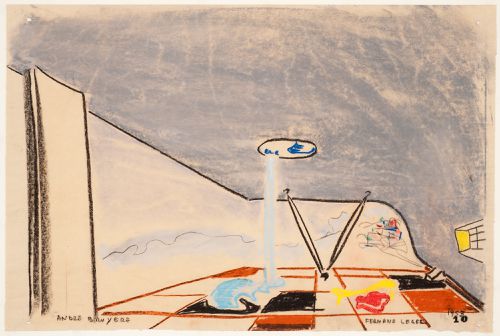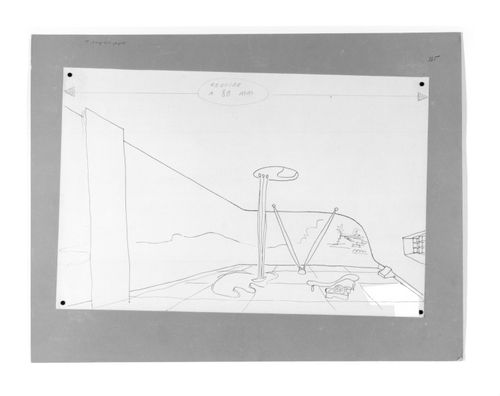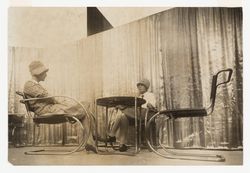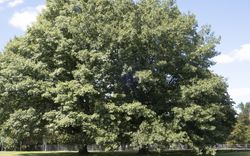Project
Carbon Tower (2001)
AP174.S1.2001.D1
Description:
This project file documents an unbuilt design by Testa & Weiser for Carbon Tower (2001), a forty-storey building made almost entirely of carbon fibre. The project was developed in parallel with scripting software designed while Peter Testa and Devyn Weiser co-directed the Emergent Design Group at MIT. "The tower consists of an interdependent set of parts: floor plates hang from a diagrid structure of bundled fibres reinforced by two double-helix covered ramps, which are run in and out of the structure and are themselves made of strands woven at a finer scale. A thin composite skin—glass would be too heavy—wraps the tower’s parts together. A collaboration with Arup in 2002 allowed Testa & Weiser to simplify the scheme even further, by moving all core elements, from elevators to structural supports, to the tower’s perimeter. To take full advantage of the flexibility and energy efficiency of composite materials, Testa & Weiser also imagined that the carbon fibre structures would be formed on site through a process called pultrusion."[1] The file contains a large number of digital files documenting the conceptual and design development of the project; consultation with Arup Consulting Engineers, New York; research on composite materials; fabrication of 3D printed physical models by 3D Systems and Windform; and exhibition of the project at several museums and galleries, including the Museum of Contemporary Art, Los Angeles and the Cooper-Hewitt Smithsonian Design Museum, New York. Also contained in the file are 56 paper drawings (including some sketches done on top of printed computer-aided designs) and two 3D printed physical models produced by 3D Systems. Sources: [1] Canadian Centre for Architecture. Archaeology of the Digital 12: Testa & Weiser, Carbon Tower, ed. Greg Lynn (2015), ISBN 978-1-927071-25-0.
2002-2014
Carbon Tower (2001)
Actions:
AP174.S1.2001.D1
Description:
This project file documents an unbuilt design by Testa & Weiser for Carbon Tower (2001), a forty-storey building made almost entirely of carbon fibre. The project was developed in parallel with scripting software designed while Peter Testa and Devyn Weiser co-directed the Emergent Design Group at MIT. "The tower consists of an interdependent set of parts: floor plates hang from a diagrid structure of bundled fibres reinforced by two double-helix covered ramps, which are run in and out of the structure and are themselves made of strands woven at a finer scale. A thin composite skin—glass would be too heavy—wraps the tower’s parts together. A collaboration with Arup in 2002 allowed Testa & Weiser to simplify the scheme even further, by moving all core elements, from elevators to structural supports, to the tower’s perimeter. To take full advantage of the flexibility and energy efficiency of composite materials, Testa & Weiser also imagined that the carbon fibre structures would be formed on site through a process called pultrusion."[1] The file contains a large number of digital files documenting the conceptual and design development of the project; consultation with Arup Consulting Engineers, New York; research on composite materials; fabrication of 3D printed physical models by 3D Systems and Windform; and exhibition of the project at several museums and galleries, including the Museum of Contemporary Art, Los Angeles and the Cooper-Hewitt Smithsonian Design Museum, New York. Also contained in the file are 56 paper drawings (including some sketches done on top of printed computer-aided designs) and two 3D printed physical models produced by 3D Systems. Sources: [1] Canadian Centre for Architecture. Archaeology of the Digital 12: Testa & Weiser, Carbon Tower, ed. Greg Lynn (2015), ISBN 978-1-927071-25-0.
Project
2002-2014
archives
Level of archival description:
Fonds
AP177
Synopsis:
The RUR Architecture Kansai-kan of the National Diet Library project records, circa 1996, document the New York based firm’s competition entry for the Kansai Science City branch of Japan’s National Diet Library. Records show integration of landscape in the building’s design, exploration of the relationship between structure and surface, and a multimedia approach to building design. Records include 169 digital files, mostly CAD models and images; 42 drawings and printed renderings; and 5 models and casts.
1996-2015
RUR Architecture Kansai-kan of the National Diet Library project records
Actions:
AP177
Synopsis:
The RUR Architecture Kansai-kan of the National Diet Library project records, circa 1996, document the New York based firm’s competition entry for the Kansai Science City branch of Japan’s National Diet Library. Records show integration of landscape in the building’s design, exploration of the relationship between structure and surface, and a multimedia approach to building design. Records include 169 digital files, mostly CAD models and images; 42 drawings and printed renderings; and 5 models and casts.
archives
Level of archival description:
Fonds
1996-2015
DR1996:0002
Description:
- Two groups of four pastel drawings were originally produced in connection with the Village Polychrome project. The architect André Bruyère had retained one group, while the other was given to the patron and client, Francisco de Assis Chateaubriand Bandeira de Melo, who then donated it to the Sao Paolo Museum of Modern Art. Bruyère subsequently gave one of the four drawings in his group to a friend. The three remaining drawings from Bruyère's group are in the CCA Prints and Drawings collection (DR1996:0001 - DR1996:0003) ("Projet de Village Polychrome, Biot, France"). - The sliding wall, shown on the left, can be used to partially enclose the terrace ("Village d'artistes sur la Côte d'Azur", p. 83).
interior design
1953
Perspective for a guest villa showing the terrace, Village Polychrome, near Biot, France
Actions:
DR1996:0002
Description:
- Two groups of four pastel drawings were originally produced in connection with the Village Polychrome project. The architect André Bruyère had retained one group, while the other was given to the patron and client, Francisco de Assis Chateaubriand Bandeira de Melo, who then donated it to the Sao Paolo Museum of Modern Art. Bruyère subsequently gave one of the four drawings in his group to a friend. The three remaining drawings from Bruyère's group are in the CCA Prints and Drawings collection (DR1996:0001 - DR1996:0003) ("Projet de Village Polychrome, Biot, France"). - The sliding wall, shown on the left, can be used to partially enclose the terrace ("Village d'artistes sur la Côte d'Azur", p. 83).
interior design
DR1996:0011
Description:
- Two groups of four pastel drawings were originally produced in connection with the Village Polychrome project. The architect André Bruyère had retained one group, while the other was given to the patron and client, Francisco de Assis Chateaubriand Bandeira de Melo, who then donated it to the Sao Paolo Museum of Modern Art. Bruyère subsequently gave one of the four drawings in his group to a friend. The three remaining drawings from Bruyère's group are in the CCA Prints and Drawings collection (DR1996:0001 - DR1996:0003) ("Projet de Village Polychrome, Biot, France"). - The sliding wall, shown on the left, can be used to partially enclose the terrace ("Village d'artistes sur la Côte d'Azur", p. 83).
interior design
1952-1953
Perspective for a guest villa showing the terrace, Village Polychrome, near Biot, France
Actions:
DR1996:0011
Description:
- Two groups of four pastel drawings were originally produced in connection with the Village Polychrome project. The architect André Bruyère had retained one group, while the other was given to the patron and client, Francisco de Assis Chateaubriand Bandeira de Melo, who then donated it to the Sao Paolo Museum of Modern Art. Bruyère subsequently gave one of the four drawings in his group to a friend. The three remaining drawings from Bruyère's group are in the CCA Prints and Drawings collection (DR1996:0001 - DR1996:0003) ("Projet de Village Polychrome, Biot, France"). - The sliding wall, shown on the left, can be used to partially enclose the terrace ("Village d'artistes sur la Côte d'Azur", p. 83).
interior design
Join us Wednesday November 20 from 4–7 pm to honour the women who planned and designed our built environment. This event is free and open to the public.
Study Room
20 November 2024, 4pm to 7pm
Wiki Edit-a-thon: Foregrounding Canadian Women Architects
Actions:
Description:
Join us Wednesday November 20 from 4–7 pm to honour the women who planned and designed our built environment. This event is free and open to the public.
Study Room
Project
AP194.S1.1997.PR02
Description:
Project records document the design process for OCEAN North’s competition entry for the Jyväskylä Music and Arts Centre in 1997. The project was titled Terra Cultura by OCEAN North. The competition was to create a multi-usage space that would include a venue for the symphonic orchestra, a music school, exhibition spaces and the possibility to host a variety of small cultural events in the Finnish city of Jyväskylä. The proposed site is in the center of the town, across the street from the Jyväskylä city church and its park, and nearby buildings designed by Alvar Aalto. OCEAN North’s concept presents a topological surface as an extension of the surrounding urban scape with two masses that would host the formal functions of the building (concert hall, music school, exhibition halls). The two volumes, or raised blocks, are divided along a diagonal elevated space, which is the extension of the ground’s topological surface filled and dubbed “Liquid Flow Space” by the design team. In their interview with Greg Lynn, Johan Bettum and Kivi Sotamaa mentioned that the idea for Jyväskylä was that it was a cloud. To reach this goal, the team used CAD software to trace streams of particles as a modelling approach. The masses of linear elements that were generated were further deconstructed and turned into “peels” and rearranged to create the masses of the building. Physical models were also used to test and further what had emerged from the digital design process, with results being fed back into the digital drawings. During the process, Bettum also brought in the idea of the internalisation of the outside, taking inspiration from the Centre Georges Pompidou. Digital records document the creative process with raster and vector images, CAD drawings and models, and few digital textual records describing the project and the program charts. Drawings and models show site and building plans, perspectives and sections; particles streaming and resulting linear masses; peels and sections identified per color; and renderings of aerials, perspectives and elevation views. OCEAN North seems to have mostly used Microstation for modelling, although there are a few files created with form*Z and 3D Studio. Some of the raster images might have been created with these software as well, showing a given stage of the design process and including renderings. There are also screen captures showing the top, front, left and perspective views of 3D models. Adobe Photoshop and Illustrator were also used to create and modify drawings and diagrams. Program charts were created in Microsoft Excel. Sources: Softspace: from a representation of form to a simulation of space, Edited by Sean Lally and Jessica Young. London, New York: Routledge, 2007. Greg Lynn, ed. Archaeology of the Digital 17: OCEAN North, Jyväskylä Music and Arts Centre, Montréal: Canadian Centre for Architecture, 2017. ePub.
1997-1998
Terra Cultura – Jyväskylä Music and Arts Centre, international competition entry, Jyväskylä, Finland (1997)
Actions:
AP194.S1.1997.PR02
Description:
Project records document the design process for OCEAN North’s competition entry for the Jyväskylä Music and Arts Centre in 1997. The project was titled Terra Cultura by OCEAN North. The competition was to create a multi-usage space that would include a venue for the symphonic orchestra, a music school, exhibition spaces and the possibility to host a variety of small cultural events in the Finnish city of Jyväskylä. The proposed site is in the center of the town, across the street from the Jyväskylä city church and its park, and nearby buildings designed by Alvar Aalto. OCEAN North’s concept presents a topological surface as an extension of the surrounding urban scape with two masses that would host the formal functions of the building (concert hall, music school, exhibition halls). The two volumes, or raised blocks, are divided along a diagonal elevated space, which is the extension of the ground’s topological surface filled and dubbed “Liquid Flow Space” by the design team. In their interview with Greg Lynn, Johan Bettum and Kivi Sotamaa mentioned that the idea for Jyväskylä was that it was a cloud. To reach this goal, the team used CAD software to trace streams of particles as a modelling approach. The masses of linear elements that were generated were further deconstructed and turned into “peels” and rearranged to create the masses of the building. Physical models were also used to test and further what had emerged from the digital design process, with results being fed back into the digital drawings. During the process, Bettum also brought in the idea of the internalisation of the outside, taking inspiration from the Centre Georges Pompidou. Digital records document the creative process with raster and vector images, CAD drawings and models, and few digital textual records describing the project and the program charts. Drawings and models show site and building plans, perspectives and sections; particles streaming and resulting linear masses; peels and sections identified per color; and renderings of aerials, perspectives and elevation views. OCEAN North seems to have mostly used Microstation for modelling, although there are a few files created with form*Z and 3D Studio. Some of the raster images might have been created with these software as well, showing a given stage of the design process and including renderings. There are also screen captures showing the top, front, left and perspective views of 3D models. Adobe Photoshop and Illustrator were also used to create and modify drawings and diagrams. Program charts were created in Microsoft Excel. Sources: Softspace: from a representation of form to a simulation of space, Edited by Sean Lally and Jessica Young. London, New York: Routledge, 2007. Greg Lynn, ed. Archaeology of the Digital 17: OCEAN North, Jyväskylä Music and Arts Centre, Montréal: Canadian Centre for Architecture, 2017. ePub.
Project
1997-1998
archives
Level of archival description:
Fonds
AP137
Synopsis:
The fonds documents architectural projects from 1955-1969 by the Montréal-based firm of Affleck, Desbarats, Dimakopoulos, Lebensold, Sise. Most of the 44 projects are located in Canada, and include major buildings such as Place Ville Marie, Place Bonaventure, and the National Arts Centre in Ottawa. Two projects are in Italy, and there is a proposed exhibition pavilion for Osaka, Japan. The fonds consists primarily of architectural drawings - design development, presentation and working drawings - and some presentation panels probably used for exhibition purposes.
1955, 1957-1969
Affleck, Desbarats, Dimakopoulos, Lebensold, Sise fonds
Actions:
AP137
Synopsis:
The fonds documents architectural projects from 1955-1969 by the Montréal-based firm of Affleck, Desbarats, Dimakopoulos, Lebensold, Sise. Most of the 44 projects are located in Canada, and include major buildings such as Place Ville Marie, Place Bonaventure, and the National Arts Centre in Ottawa. Two projects are in Italy, and there is a proposed exhibition pavilion for Osaka, Japan. The fonds consists primarily of architectural drawings - design development, presentation and working drawings - and some presentation panels probably used for exhibition purposes.
archives
Level of archival description:
Fonds
1955, 1957-1969
articles
Alina
Aglaia Konrad, Alina Scholtz, Barbara Brukalska, Halina Skibniewska, Helena Syrkus, Zofia Hansen, Jelena Pančevac, Pancevac, Warsaw, landscape, housing estate, NORM, CCA Singles, Zaven Titizian
4 November 2024
Series
Projects and events
AP170.S3
Description:
Series 3, Projects and events, 1992 – 2014, documents each major installation of the Hyposurface project and consists of more than 10,000 digital files. These files include exhibition layout planning, Aegis simulator software demonstrating Hyposurface, event photographs and video, and ACDC and Aegis software related to specific events. This series also includes the majority of the material Paul Steenhuisen G5 Mac computer and the related Hyposurface audio installations. The bulk of the materials dates from 2000 – 2007. Events represented include Venice Biennale (Venice, 2000); CeBIT Technology Fair (Hannover, Germany, 2002); International Manufacturing Technology Show (IMTS, Chicago, 2006); BIO exhibition (Boston, 2007); and the Canadian Centre for Architecture (Montreal, 2013-2014). This series also contains a number of unidentified projects, including projects in Brisbane, Australia; Amsterdam, the Netherlands; and possibly Russia and Spain. There is also video documentation related to a Hyposurface proposal for BMW, as well as what appears to be a tour of Kuka Robotics staff through dECOi’s laboratory. This series contains nearly 3100 Aegis pattern files, which are identifiable by their file extension (.aeg). An additional 3100 files are plain text files, executable files, or an unidentified format, and appear to relate to other dECOi software. This series notably contains more than 2000 audio files related to the Paul Steenhuisen installations. The rest of the series contains largely still images and video, as well as a small number of AutoCAD and Rhino files. This series overlaps with Series 2: Software and related documentation. This series contains only software related to a specific project or event, while Series 2 contains software generally related to Hyposurface.
1992 - 2014
Projects and events
Actions:
AP170.S3
Description:
Series 3, Projects and events, 1992 – 2014, documents each major installation of the Hyposurface project and consists of more than 10,000 digital files. These files include exhibition layout planning, Aegis simulator software demonstrating Hyposurface, event photographs and video, and ACDC and Aegis software related to specific events. This series also includes the majority of the material Paul Steenhuisen G5 Mac computer and the related Hyposurface audio installations. The bulk of the materials dates from 2000 – 2007. Events represented include Venice Biennale (Venice, 2000); CeBIT Technology Fair (Hannover, Germany, 2002); International Manufacturing Technology Show (IMTS, Chicago, 2006); BIO exhibition (Boston, 2007); and the Canadian Centre for Architecture (Montreal, 2013-2014). This series also contains a number of unidentified projects, including projects in Brisbane, Australia; Amsterdam, the Netherlands; and possibly Russia and Spain. There is also video documentation related to a Hyposurface proposal for BMW, as well as what appears to be a tour of Kuka Robotics staff through dECOi’s laboratory. This series contains nearly 3100 Aegis pattern files, which are identifiable by their file extension (.aeg). An additional 3100 files are plain text files, executable files, or an unidentified format, and appear to relate to other dECOi software. This series notably contains more than 2000 audio files related to the Paul Steenhuisen installations. The rest of the series contains largely still images and video, as well as a small number of AutoCAD and Rhino files. This series overlaps with Series 2: Software and related documentation. This series contains only software related to a specific project or event, while Series 2 contains software generally related to Hyposurface.
Series
1992 - 2014
drawings
DR2012:0012:047:035
Description:
A planimetric map of downtown Montréal, Québec titled "Boul. Réné-Lévesque de la Rue du Fort à la Rue St. Marc. Nature des travaux: Réaménagement du mail central et reconstruction de trottoirs, là où requis". Translated, "Boulevard Réné-Lévesque from Rue du Fort to Rue St. Marc. The nature of the work is the renovation of the central mall and the reconstruction of sidewalks, where required." The roll is labelled "CCA median/ contract drawings July 2004", but contains only one item.
circa 1987-1995
Planimetric map of downtown Montréal
Actions:
DR2012:0012:047:035
Description:
A planimetric map of downtown Montréal, Québec titled "Boul. Réné-Lévesque de la Rue du Fort à la Rue St. Marc. Nature des travaux: Réaménagement du mail central et reconstruction de trottoirs, là où requis". Translated, "Boulevard Réné-Lévesque from Rue du Fort to Rue St. Marc. The nature of the work is the renovation of the central mall and the reconstruction of sidewalks, where required." The roll is labelled "CCA median/ contract drawings July 2004", but contains only one item.
drawings
circa 1987-1995



